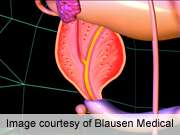For men with at least one prior negative biopsy, urinary PCA3 scores, together with serum prostate-specific antigen and other clinical information, improve the prediction accuracy for repeat biopsy outcome, according to a study published in the July issue of The Journal of Urology.
(HealthDay)—For men with at least one prior negative biopsy, urinary PCA3 scores, together with serum prostate-specific antigen and other clinical information, improve the prediction accuracy for repeat biopsy outcome, according to a study published in the July issue of The Journal of Urology.
Marc C. Gittelman, M.D., from South Florida Medical Research in Sarasota, and colleagues examined the clinical utility of the PROGENSA PCA3 Assay for predicting repeat prostate biopsy outcome. A total of 466 men with at least one prior negative prostate biopsy were enrolled in the study.
The researchers identified prostate cancer in 21.9 percent of participants. Sensitivity and specificity were 77.5 and 57.1 percent, respectively, for a PCA3 score cut-off of 25, with negative and positive predictive values of 90 and 33.6 percent, respectively. Compared to men with a score of 25 or more, those with a PCA3 score of less than 25 were 4.56-fold more likely to have a negative repeat biopsy on multivariate analysis. The predictive accuracy of the logistic regression model was improved significantly with PCA3 score. Relative to a model without PCA3 score, the addition of PCA3 score increased the specificity, positive and negative predictive values by 22.6, 6.4 and 7.1 percent, respectively, with a 90 percent sensitivity.
"The PCA3 assay supplements serum prostate-specific antigen and other clinical information for more accurately predicting repeat biopsy outcome," the authors write. "The PCA3 assay provides clinicians and patients with independent, clinically useful information to make more informed repeat biopsy decisions."
Two authors disclosed financial ties to EDAP and to Gen-Probe, which manufactures the PROGENSA PCA3 Assay and funded the writing of the manuscript.
More information:
Abstract
Full Text
Journal information: Journal of Urology
Health News Copyright © 2013 HealthDay. All rights reserved.



















